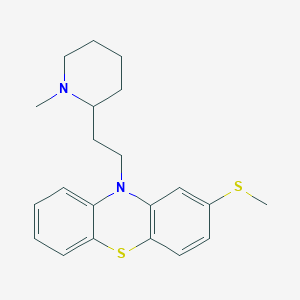Drug Information
| General Information | ||||||
|---|---|---|---|---|---|---|
| Drug ID |
DR00785
|
|||||
| Drug Name |
Thioridazine
|
|||||
| Synonyms |
(+-)-Thioridazine; 10-(2-(1-Methyl-2-piperidyl)ethyl)-2-(methylthio)phenothiazine; 10-[2-(1-methyl-2-piperidyl)ethyl]-2-methylsulfanyl-phenothiazine; 10-[2-(1-methylpiperidin-2-yl)ethyl]-2-(methylsulfanyl)-10H-phenothiazine; 10-[2-(1-methylpiperidin-2-yl)ethyl]-2-(methylthio)-10H-phenothiazine; 10-[2-(1-methylpiperidin-2-yl)ethyl]-2-methylsulfanylphenothiazine; 2-Methylmercapto-10-(2-(N-methyl-2-piperidyl)ethyl)phenothiazine; 3-Methylmercapto-N-(2'-(N-methyl-2-piperidyl)ethyl)phenothiazine; Aldazine; Dl-Thioridazine; Mallorol; Malloryl; Meleril; Mellaril; Mellaril (*Hydrochloride*); Mellaril (TN); Mellaril-S; Mellaril-S (TN); Mellarit; Mellerets; Mellerette; Melleretten; Melleril; Melleril (liquid); Melleryl; Metlaril; Novoridazine; Novoridazine (TN); Orsanil; Ridazine; Sonapax; Stalleril; TP-21; Thioridazin; Thioridazine (USP/INN); Thioridazine Hcl; Thioridazine Hcl Intensol; Thioridazine [USAN:INN:BAN]; Thioridazine prolongatum; Thioridazine, prolongatum; Thioridazinum; Thioridazinum [INN-Latin]; Thioril (TN); Thioxidazine; Thoridazine hydrochloride; Tioridazin; Tioridazina; Tioridazina [INN-Spanish]
|
|||||
| Drug Type |
Small molecular drug
|
|||||
| Indication | Schizophrenia [ICD11: 6A20] | Approved | [1] | |||
| Therapeutic Class |
Antipsychotic Agents
|
|||||
| Structure |
|
 |
||||
| 3D MOL | 2D MOL | |||||
| Formula |
C21H26N2S2
|
|||||
| Canonical SMILES |
CN1CCCCC1CCN2C3=CC=CC=C3SC4=C2C=C(C=C4)SC
|
|||||
| InChI |
InChI=1S/C21H26N2S2/c1-22-13-6-5-7-16(22)12-14-23-18-8-3-4-9-20(18)25-21-11-10-17(24-2)15-19(21)23/h3-4,8-11,15-16H,5-7,12-14H2,1-2H3
|
|||||
| InChIKey |
KLBQZWRITKRQQV-UHFFFAOYSA-N
|
|||||
| CAS Number |
CAS 50-52-2
|
|||||
| Pharmaceutical Properties | Molecular Weight | 370.6 | Topological Polar Surface Area | 57.1 | ||
| Heavy Atom Count | 25 | Rotatable Bond Count | 4 | |||
| Hydrogen Bond Donor Count | 0 | Hydrogen Bond Acceptor Count | 4 | |||
| XLogP |
5.9
|
|||||
| PubChem CID | ||||||
| ChEBI ID |
ChEBI:9566
|
|||||
| TTD Drug ID | ||||||
| DT(s) Transporting This Drug | P-GP | Transporter Info | P-glycoprotein 1 | Substrate | [2] | |
| References | ||||||
| 1 | Thioridazine was approved by FDA. The official website of the U.S. Food and Drug Administration. (2019) | |||||
| 2 | Improving the prediction of the brain disposition for orally administered drugs using BDDCS. Adv Drug Deliv Rev. 2012 Jan;64(1):95-109. | |||||
If you find any error in data or bug in web service, please kindly report it to Dr. Yin and Dr. Li.
